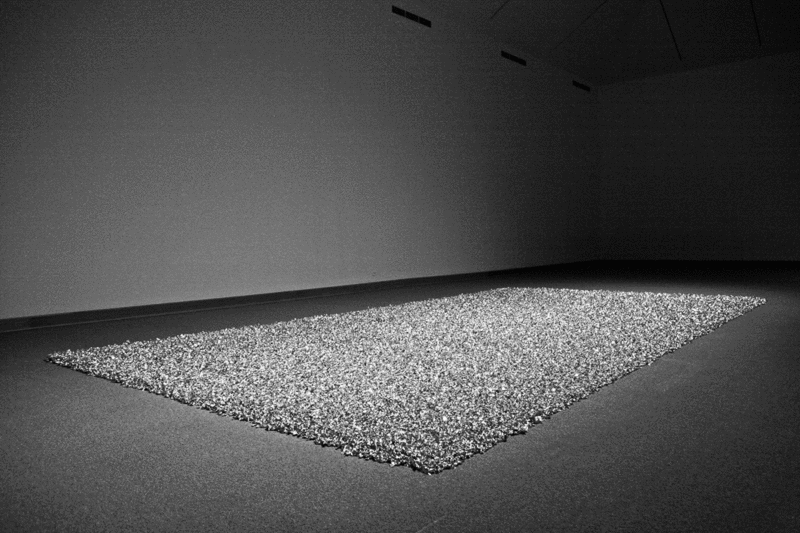
In our sugar-laden society, one can often tell the time of year by the candy—peppermint sticks mean that it’s Christmas, chocolate eggs signify Easter, and candy corn can only mean Halloween. But what does one make of a sculpture that consists of 1,200 pounds of hard candy deposited in a gallery, with all 40,000 individual pieces wrapped in seasonally ambiguous shining silver?
The candies do not refer to any particular holiday or tradition, but the work, Untitled (Placebo), a 1991 creation by Felix Gonzalez-Torres now installed at the Williams College Museum of Art, marks time in a different way. As visitors view the sculpture, they are encouraged to take a piece of it with them. Over the course of the exhibition, the carpet of candies that covers the gallery floor thins out, and maybe even disappears. In effect, the art evaporates.
Gonzalez-Torres made a lot of such interactive, take-some-with-you artworks. He called them public art, a term that usually describes big, heavy, durable sculptures in outdoor locations. “I want to make art for people who watch the Golden Girls and sit in a big, brown La-Z-Boy chair,” he said. Along with his “candy spills,” Gonzalez-Torres is also known for his “stacks”—vast copies of enigmatic texts, newspaper clippings, even blank sheets of paper, piled two to three feet high. Again, viewers are encouraged to take a page, and slowly the piece fades away.
Untitled (Placebo) speaks not just about the elusive flow of time but also about the era in which it was created and the circumstances of the artist’s brief life. The Cuban-born Gonzalez-Torres died of AIDS in 1996 at age 39, one year after being honored with a career retrospective at the Guggenheim Museum in New York City. His partner, Ross—who he always called the muse, inspiration, and main audience for his art—had succumbed to the disease in 1991.
“I wanted to make art that could disappear, that never existed,” said Gonzalez-Torres of Placebo, “and it was a metaphor for when Ross was dying.” Given its title, the piece could also be a commentary on the highly toxic yet ultimately ineffective drugs given to AIDS patients at the time.
The loss of his partner became Gonzalez-Torres’s overriding motif in the ’90s. One of his most widely viewed pieces during this era was a photograph of their empty bed. It was taken shortly after Ross’s death and reproduced on billboards around Manhattan, thanks to sponsorship from the Museum of Modern Art. Such poignant statements about memory, pain, and longing stood in sharp contrast to the more confrontational art of the time.
In the midst of the culture wars of the early 1990s, an exhibit of Gonzalez-Torres’s work was shown at the Hirshhorn Museum in Washington. A story goes that a Republican senator made a point of attending the opening, convinced that this exhibit of gay art would include incendiary pornographic images. What he found was the candy of Untitled (Placebo), and another work, Untitled (Perfect Lovers), a pair of clocks hanging side by side, synchronized down to the second hands.
Untitled (Placebo) remains on view at the Williams College Museum of Art in Williamstown through March 23. (413) 597-2429; www.wcma.org.












